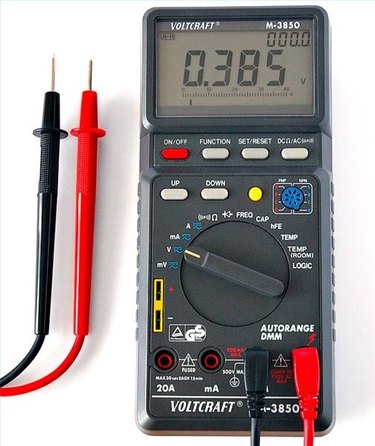
What Is a Multimeter?

Multimeters are tools used to troubleshoot electrical and electronic circuits. They are also used to check voltages to ensure correct operating levels. The most common models measure voltage, current and resistance. More expensive models can also measure capacitance and inductance. A meter is a measuring instrument. An ammeter measures current; a voltmeter measures the voltage between two points; and an ohmmeter measures resistance. A multimeter combines these functions into a single instrument A multimeter can be used to measure voltage, current and resistance in an electrical circuit that uses resistors and capacitors. To understand how to use a multimeter with these components, schematic symbols for resistors, capacitors and other electronic schematic symbols need to be readily recognized
The Ammeter
Video of the Day
The ammeter function of a multimeter measures the number of electrons that are passing a given point in a certain amount of time. This measurement is a measure of current and the units are called amperes. To understand how much an ampere is, the typical household circuit breaker is rated to open at 15 or 20 amperes. A multimeter can be used to check how many amperes a household appliance is drawing to see if it is drawing excessive current, causing a circuit breaker to open.
Video of the Day
The Voltmeter
The voltmeter function of a multimeter measures the electrical potential between two points and is measured in volts. For a 9-volt battery, the potential between the positive and negative terminals of the battery is nine volts and can be checked with a multimeter. This is often useful when a battery is suspected to be near the end of its life.
The Ohmmeter
The ohmmeter function of a multimeter measures the resistance to current flow. This measurement is given in units called ohms. If an electrical circuit is "short-circuited," then its resistance is zero or near zero ohms. If a circuit is open, then it has infinite resistance and there is no current flow.
Modes of Current
Multimeters have the capacity to measure current and voltage in two different modes, alternating current, or AC, and direct current, or DC. The standard for household voltage outlets is alternating current. Different countries have different standards for household A.C. voltage, which is why many travelers find their 120 AC volt hair dryers malfunction when plugged into an outlet in a foreign country. If the voltage isn't known, it's helpful to check the voltage with a multimeter using the AC voltmeter function. Batteries supply DC current, while households supply AC current. When a current measurement is made, the multimeter must be set in the correct function, AC or DC, in order to obtain an accurate measurement.